Demand for greener, more sustainable technologies in pharma, agro and fine chemicals sectors is growing – catalysis is at the heart of this transformation
Johnson Matthey (JM) – a global leader in applying catalytic science to make the world cleaner and healthier – is working with the fine chemicals industry to provide the innovative solutions needed to meet the expanding demand for sustainable manufacturing. JM catalysts – heterogeneous, homogeneous and biological and enzymatic – are embedded in a vast number of processes, enabling the safe and efficient production of key intermediates and active pharmaceutical ingredients (API) that benefit customers and patients worldwide.
The development of a technically and economically viable industrial scale catalytic process is a complex task that requires multi-discipline collaboration. JM devises and delivers bespoke solutions that help customers create value. All of our research groups have expertise in complementary technologies – heterogeneous, homogeneous reduction and cross-coupling, biocatalysis. This allows JM to focus on providing an optimal, unbiased catalytic solution.
Successful catalysis of complex molecules is a highly collaborative process
An internal survey of more than 400 collaborative project schedules since 2013 shows an almost equal distribution among the four technologies (see Figure 1).
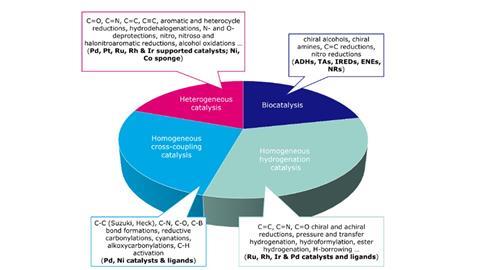
The right catalytic solution
The pathway to a successful catalytic production of a complex molecule, such as an active ingredient or API, is a highly collaborative process (Figure 2) requiring input from experts at every stage and discussion to answer complex questions, for example:
- Route scouting: Can this transformation be catalytic? Which technology and catalyst? Under what conditions?
- Process development and scale-up: Is the process safe, scalable and robust? How can we maximise productivity?
- Catalyst supply: Is the catalyst available on scale? Is the supply chain secure?
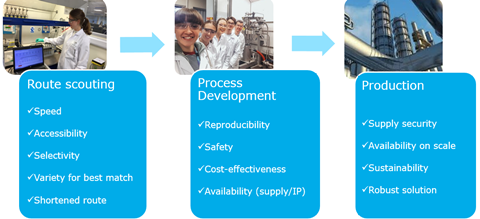
The increasing complexity of many targets – and need for competitiveness and sustainability – requires tailored solutions, which are facilitated by the availability of complementary chemo- and bio-catalytic technologies.
At JM, a wide availability of established catalyst technologies can be applied to the majority of our customers’ chemistries. However, in some cases, a more unique solution may be required. For example, this could involve the development of a new heterogeneous catalyst with improved re-use capabilities, or the need for a more active and enantioselective homogeneous catalyst for a chiral reduction. With this in mind, a new multi-kilogram facility (called the CatLab) for the development of homogeneous catalysts is now operational in JM’s Cambridge labs. This will facilitate bespoke catalyst manufacturing projects and/or demonstration of our catalysts in action when applied to a customer’s process.
JM recognises that today’s chemical industry can be fast-moving and our customers are looking for more than a simple product supplier. Instead, JM prefers to act as a comprehensive solution provider and our team is always on hand to provide technical guidance every step of the way. Advice is available on initial catalyst hit identification to process optimisation to commercialisation of the reaction on full industrial scale.
Support for customers’ applications often takes the form of recommendations on catalyst choices and reaction conditions, for example how to reduce a C=O selectively in the presence of a C=C bond, or nitro group in the presence of an aryl-halide. It may be advice on overcoming specific problems like by-product formation upon reaction scale-up. Discussion can happen with different levels of disclosure – as appropriate to the situation – and our approach draws on the vast experience that the JM team has developed over the years.
Success: How we collaborate to drive innovation
Two projects are rarely the same. At JM, our continued commitment to collaboration with organisations allows us to drive innovation throughout the supply ecosystem to develop breakthrough ideas. Five pillars guide our successful collaborations:
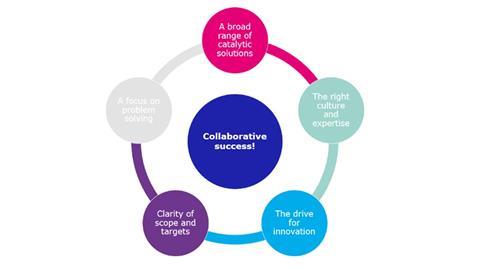
- The right culture and expertise are based on hands-on multi-years’ experience in the field of industrial catalysis. The value of this massive collective experience comes from combining high customer-focus with an inquisitive R&D mentality.
- A focus on problem-solving ensures that projects are managed through detailed weekly reports and teleconferences, allowing for flexible redirection of resources at any stage. The interests of a catalyst provider and end-users are aligned: the only sustainable projects are the ones that create value.
- The drive for innovation: At JM we are constantly in search of innovative catalysts and processes, aiming to improve the properties of catalyst and process that can translate to overall process efficiency.
- Clarity of scope and targets: Expectations must be well understood and matched to the resources allocated.
- A broad range of catalytic solutions: JM offers an extensive range of commercial catalysts (heterogeneous, homogeneous and biocatalysts) designed to cover the main applications in the fine chemicals space. If a more bespoke solution is required, we have the expertise in place to ensure our customers should never settle for second best.
Customer-funded collaborative projects involve the JM team actively working on bespoke solutions to help our customers. The approach relies on our access to libraries of catalysts (irrespective of whether they are transition metal catalysts or enzymes) and the know-how to optimise the application of these smart technologies to maximise their value, with a knowledge-based approach to catalyst selection and screening, the use of kinetics and design of experiment at the laboratory optimisation stage and an early focus on cost-modelling of the process. Figure 3 shows examples of complementary use of chemo- and bio-catalytic technologies in asymmetric catalytic reductions.

The equipment and facilities are a required component for success in catalyst screening with well-understood validity and laboratory-scale demonstration for a knowledge-based approach to catalyst identification and reaction optimisation.
- Modern analytical instrumentation covers all fundamental techniques from monitoring reactions (UPLC, HPLC, SFC, GC) to the characterisation of products and side-products (NMR, LC/MS) and specific analytical methods can be developed when and if required.
- Homogeneous cross-coupling and transfer hydrogenation catalysis benefits from fast scanning of a high number of catalysts and reaction condition combinations using practical small-scale screen using vials and multi-well hotplates.
- Pressure hydrogenation (with heterogeneous or homogeneous catalysts) requires more specialised screening equipment with an early attention to scalability and potential mass transfer limitations. Figure 4 shows the workflow of a chiral hydrogenation catalyst screen.
- Biocatalysis allows very rapid screening of libraries on an even smaller scale. A high-throughput workflow (from robotic colony-pickers to an array of UPLCs for rapid analysis) is suitable for the enzyme engineering projects when several rounds of libraries screening may be required.

Bringing it all together
Achieving success in the development of a sustainable catalytic process is a highly collaborative endeavour. The flexible approach offered by JM enables access to readily available options for fast implementation, as well as an opportunity to explore more novel and bespoke catalyst solutions. Far from being just a catalyst supplier, JM has the experience to support the application of innovative catalysts in users’ hands to ensure that the most competitive catalytic route is chosen. Our goal is to deliver solutions that meet end-users’ criteria at all stages of the workflow, from route identification to production, with the capacity to reliably supply high-quality catalysts at full-commercial scale from our global network of manufacturing organisations around the world.
Find out about the article’s authors below:

Damian Grainger is JM’s team leader, catalysis screening projects.

Lucy Milner is JM’s new business development manager.

Danny Mortimer is JM’s product specialist, heterogeneous catalysis.

He studied in Milano, Italy, completing his PhD in organometallic chemistry in 1994.








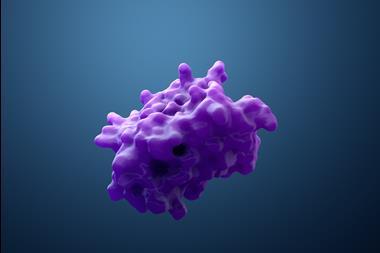
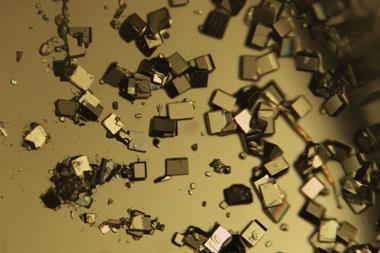




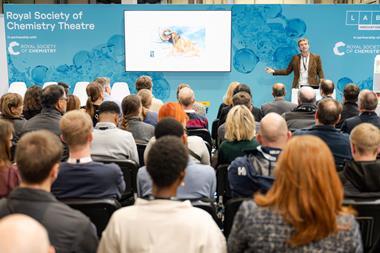


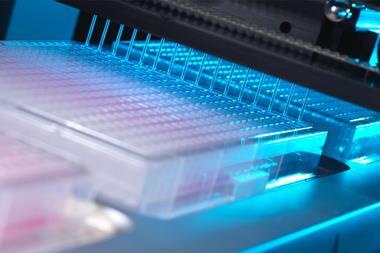
No comments yet